Here’s what I think. I think we think too much.
Sometimes.
About art.
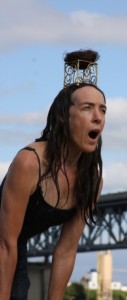 About visual art, definitely. We’ve created a mumbo-jumbo priesthood of commentary and pretend the intellectual abstraction is more important than the physical experience of the art itself. Which it is, but only sometimes. And far less often than the priesthood likes to think.
About visual art, definitely. We’ve created a mumbo-jumbo priesthood of commentary and pretend the intellectual abstraction is more important than the physical experience of the art itself. Which it is, but only sometimes. And far less often than the priesthood likes to think.
Also about dance, which on the face of it is about as physical and sensual as an art form can be: One’s body is one’s art. That doesn’t mean dance isn’t driven by ideas, from folk styles to ballet and modern and the most contemporary expression. Yet in no other art form is it so literally true that an artist creates a body of work.
On Friday night Portland was happily busting the spine of an unPortland-like heat wave, but the word hadn’t drifted up to the fourth floor of downtown’s Pythian Building, where giant fans were whooshing to keep the sticky air circulating at Conduit Dance. Conduit’s in a bit of a pickle financially right now, and so it’s putting on a series of benefit performances this weekend and next, and Friday was opening night.
A hot and sticky affair, as it turned out: For a change, the audience got a feel for what it’s like to be out on the floorboards, sweating under the lights. Because so much of the audience was made up of dance people, anyway, it just helped to create a here-we-are-together mood. And because the wet heat had the mildly giddy effect of a low-grade fever, it encouraged dispensing with analysis and just experiencing the thing. As Paul McCartney put it, Let it be.
For years I’ve watched Linda Austin, a smart and funny woman who’s established herself as one of the city’s leading contemporary performers, and for years I just haven’t quite got what she’s up to. Linda’s out there, and I’ve spent a bit of time trying to figure out where “there” is and exactly why she’s taking us to it. In that suss-out-the-puzzle sense her Friday night performance, a solo study for her work-in-progress Bandage a Knife, was pretty familiar in its unfamiliarity: Who besides Linda knows what that chanting and waving of lights was all about?
Continue reading Hot and sweaty at Conduit Dance: Don’t think, just feel
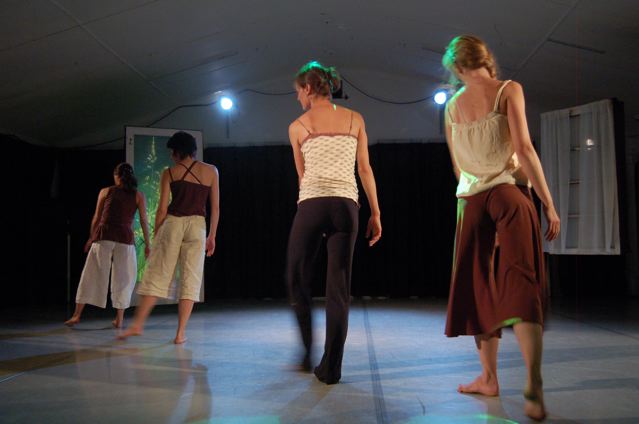
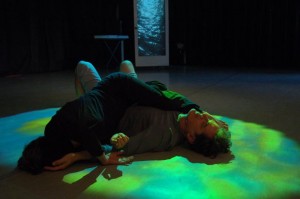 The show began with TouchMonkey, in the persons of Carolyn Stuart and Patrick Gracewood, who are longtime practitioners of Contact Improvisation, a form based on trust and the ability to make on-the-spot kinetic connections. Stuart was wearing a black cloth over her eyes, which meant her responses to Gracewood were entirely by touch and contact. Their duet, titled Special Alembics, (nice pun!) was performed to music played live by Eddy Deane, Alley Teach, and David Lyles of The Contact Lounge Band.
The show began with TouchMonkey, in the persons of Carolyn Stuart and Patrick Gracewood, who are longtime practitioners of Contact Improvisation, a form based on trust and the ability to make on-the-spot kinetic connections. Stuart was wearing a black cloth over her eyes, which meant her responses to Gracewood were entirely by touch and contact. Their duet, titled Special Alembics, (nice pun!) was performed to music played live by Eddy Deane, Alley Teach, and David Lyles of The Contact Lounge Band.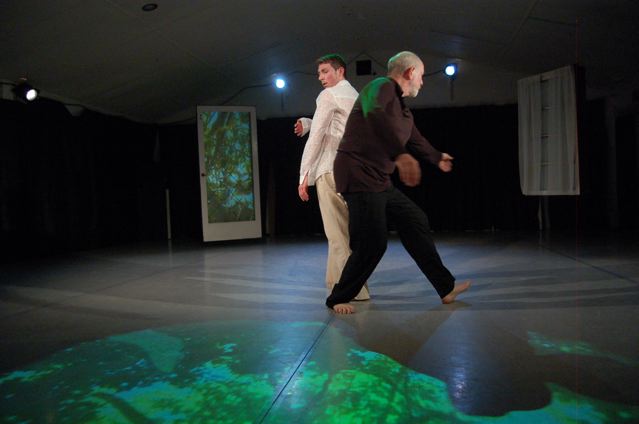
 Really, it was a cross between a potlatch and an Obama rally, a gathering of the clans.
Really, it was a cross between a potlatch and an Obama rally, a gathering of the clans.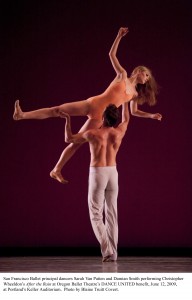 The Joffrey Ballet’s Aaron Rogers, performing Val Caniparoli’s Aria, recalled for me the profound pleasure of watching Val work with Portland dancers, first at OBT’s precursor Ballet Oregon, and then at OBT. Caniparoli’s kindness and courtesy in the studio turned out to be extremely productive when the company performed his Street Songs and other work. Rogers looked like he was enjoying himself, flirting with that mask, and certainly seduced the audience in the process.
The Joffrey Ballet’s Aaron Rogers, performing Val Caniparoli’s Aria, recalled for me the profound pleasure of watching Val work with Portland dancers, first at OBT’s precursor Ballet Oregon, and then at OBT. Caniparoli’s kindness and courtesy in the studio turned out to be extremely productive when the company performed his Street Songs and other work. Rogers looked like he was enjoying himself, flirting with that mask, and certainly seduced the audience in the process.